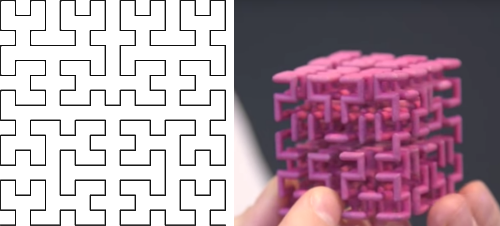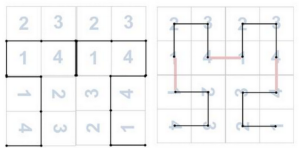The Gosper curve is one of the most amazing and satisfying plane-filling curves.

The Gosper curve is a self-avoiding, plane-filling fractal curve containing 7^n segments (where n is the order of the teragon). It approximates the shape of a hexagon. It is named after the mathematician William Gosper.
Like all plane-filling curves generated using a deterministic recursive algorithm, the Gosper curve can be mapped to a tiling. In this case, the tile is the hexagon. As you increase the order of the teragon, the number of line segments – and thus hexagons – increases. And the boundary becomes more rugged. Below at right is an image of the Gosper boundary, created by the tiling of seven “rep-tiles“, each self-similar to the whole shape.
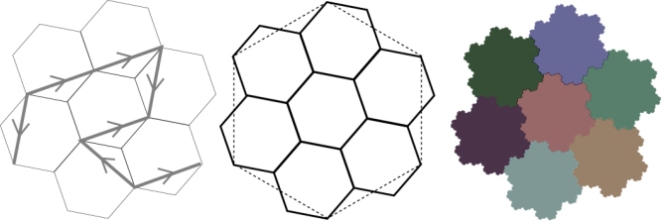
Counting Pennies
The regular hexagon is similar to the circle in the sense that the close-packing of circles forms a hexagonal arrangement. Imagine having 343 (7^3) pennies arranged on a table. If you try to push them together into the smallest area you can, you might end up approximating the shape of the Gosper curve.
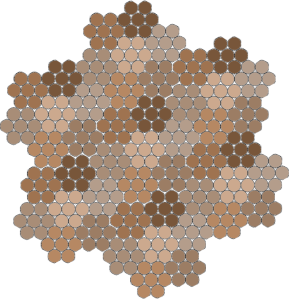
 There are many ways to count a bunch of pennies. In this case you could count them in the order of the Gosper curve’s sweep. Since it is recursive, you could pause every 7 pennies to catch your breath. And you could also pause every 49 pennies for longer breaks. Between each break, you will have traced out a low-order Gosper curve.
There are many ways to count a bunch of pennies. In this case you could count them in the order of the Gosper curve’s sweep. Since it is recursive, you could pause every 7 pennies to catch your breath. And you could also pause every 49 pennies for longer breaks. Between each break, you will have traced out a low-order Gosper curve.
On To the Third Dimension
Now, what if we extend this idea to three dimensions? Well, consider the close-packing of spheres. In the case of spheres, there are 12 spheres that can surround a single sphere, making a clump with a total of 13 spheres.
And…just as close-packing circles correspond to the tiling hexagon, 3D circles (spheres) correspond to the tiling rhombic dodecahedron.
Rhombic dodecahedra can be tiled infinitely, leaving no gaps and having no overlaps. This brings us to the big question: might there be a 3D spacefilling curve that can be drawn within a volume which is the union of 13^n rhombic dodecahedra? In other words…
Is there such a thing as a 3D Gosper Curve?
Now, to be fair…asking this question is a bit like asking, “Is there a 3D Mandelbrot Set?” The boring but true answer is no, of course not! …because the canonical Mandelbrot Set is by definition a 2D object. Also, the mathematical properties of complex numbers do not translate into 3D.
 You may be able to find a 4D analog of the Mandelbrot Set by skipping the third dimension and jumping over to the fourth dimension. (Hamilton tried in vain to find a 3D analog of complex numbers. And this led him to the next dimension – where he discovered quaternions). FYI – the Mandebrot Set’s 2D nature didn’t stop explorers from trying to find a higher being. And in the process, what they found was something extraordinary: The Mandelbulb.
You may be able to find a 4D analog of the Mandelbrot Set by skipping the third dimension and jumping over to the fourth dimension. (Hamilton tried in vain to find a 3D analog of complex numbers. And this led him to the next dimension – where he discovered quaternions). FYI – the Mandebrot Set’s 2D nature didn’t stop explorers from trying to find a higher being. And in the process, what they found was something extraordinary: The Mandelbulb.
Now, back to the 3D Gosper curve. Is there is anything we can call a “3D Gosper curve”? To earn that title, it would have to have some fundamental attributes in common with the Gosper curve. This is what I had in mind as I set out to discover this elusive higher being. As a template, I chose the tessellation of 13 rhombic dodecahedra, because it it similar to the tessellation of 7 hexagons.
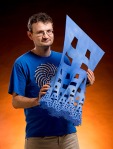 I posed my question to mathematician Henry Segerman. Just as you can tile seven hexagons (one in the middle surrounded by six), you can analogously tile thirteen rhombic dodecahedra (one in the middle surrounded by twelve). But can you then take 13 of these shapes and tile them into a larger blob of 13^3 dodecs? To explore the problem, Henry came up with the following images that he created using Rhino. After only two levels of recursion, he came to the conclusion that they probably do not tile !!!!
I posed my question to mathematician Henry Segerman. Just as you can tile seven hexagons (one in the middle surrounded by six), you can analogously tile thirteen rhombic dodecahedra (one in the middle surrounded by twelve). But can you then take 13 of these shapes and tile them into a larger blob of 13^3 dodecs? To explore the problem, Henry came up with the following images that he created using Rhino. After only two levels of recursion, he came to the conclusion that they probably do not tile !!!!
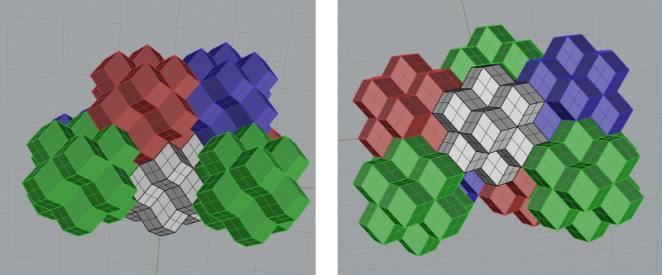
I asked Henry to send me the file for this 3D model, and then asked my colleague Barry Stump to fabricate it on his 3D printer. Here’s what Barry came up with:
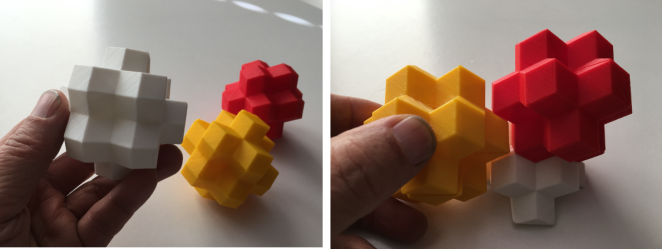
Well, three of these shapes tessellate. But we need to tessellate 13 of them with the same symmetry as the original 13 unit tiles – to see with our own eyes and feel with our own hands – before we can be sure.
Before even asking whether a space-filling curve can be drawn that traverses each dodecahedron, I needed to determine whether the overall space can recursively tile without limit, and with no gaps or overlaps. If the answer is negative, then there is no use in asking about the curve, because it would not extend infinitely, as in the case of the canonical Gosper curve.
The jury is out. But it’s not looking good. A proof that it cannot be done would be better than nothing.
On Filling Fractal Dimensions
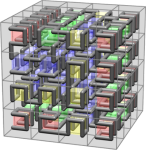 It is well known that the Hilbert curve can be extended into 3D, as was shown in The Algorithmic Beauty of Plants. (Dave Fracchia did the raytrace rendering of this on an old SGI machine – back in the day 🙂 Anyway, there are still many unanswered questions. I have a feeling that certain people (like Henry) will have key insights about this. Henry has created physical versions of the Hilbert curve. This is an example of a 3D space-filling curve that has a direct analog in 2D. So what is it about the Hilbert curve that allows it to extend into 3D?
It is well known that the Hilbert curve can be extended into 3D, as was shown in The Algorithmic Beauty of Plants. (Dave Fracchia did the raytrace rendering of this on an old SGI machine – back in the day 🙂 Anyway, there are still many unanswered questions. I have a feeling that certain people (like Henry) will have key insights about this. Henry has created physical versions of the Hilbert curve. This is an example of a 3D space-filling curve that has a direct analog in 2D. So what is it about the Hilbert curve that allows it to extend into 3D?
My original line of inquiry was this: think of the Hilbert curve in terms of tiling squares. The 2D Hilbert curve maps a line of length 2 to a square of area 2^2 = 4. The 3D Hilbert curve maps a line of length 2 to a cube of volume 2^3 = 8. The idea of the Hilbert curve as progressive squaring is described in my blog post comparing the Hilbert curve with the Peano Sweep:
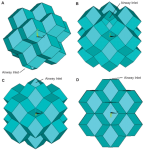 Could the same logic be used with other shapes? Other than the cube, the logical 3D tessellating shape in my mind is the rhombic dodecahedron. But it appears not to tesselate recursively to create rep-tiles. My hope was (and still is) that there exists a tiling polyhedron within which one can fit a line between vertices having a length equal to the cube root of 13, and that 13 of these would tile to form a volume of 13. But am I misguided by looking for the cube root? Perhaps I need to consider the square root? (The Euclidean distance).
Could the same logic be used with other shapes? Other than the cube, the logical 3D tessellating shape in my mind is the rhombic dodecahedron. But it appears not to tesselate recursively to create rep-tiles. My hope was (and still is) that there exists a tiling polyhedron within which one can fit a line between vertices having a length equal to the cube root of 13, and that 13 of these would tile to form a volume of 13. But am I misguided by looking for the cube root? Perhaps I need to consider the square root? (The Euclidean distance).
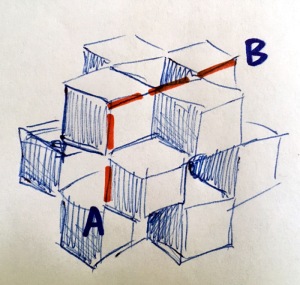 Here’s a picture I drew of 13 unit cubes representing rhombic dodecahedra. (BTW – if you stellate each face of a cube by adding a square pyramid, it becomes a rhombic dodecahedron. And if you start with a “3D checkerboard” of 13 cubes, like I have drawn, the result is 13 tessellating rhombic dodecahedra. Cool, eh? Now, look at red lines in the drawing. the distance from A to B happens to be the square root of 13 (assuming unit cubes).
Here’s a picture I drew of 13 unit cubes representing rhombic dodecahedra. (BTW – if you stellate each face of a cube by adding a square pyramid, it becomes a rhombic dodecahedron. And if you start with a “3D checkerboard” of 13 cubes, like I have drawn, the result is 13 tessellating rhombic dodecahedra. Cool, eh? Now, look at red lines in the drawing. the distance from A to B happens to be the square root of 13 (assuming unit cubes).
A line drawn from A to B might be analogous to the line drawn within the hexagon in the image at the beginning of this article. Am I missing something?
I have a feeling that there are answers right around the corner. And it may be that I am simply asking the wrong questions!
And it still may be that we have to jump over the third dimension to the land of quaternions to get the right answers. There, we might find a new realm of hyper-space-filling curves – living among the integer quaternions – analogous to the Gaussian and Eisenstein integers, which are integral domains in which number theory can be used to make sense of space-filling curves.


